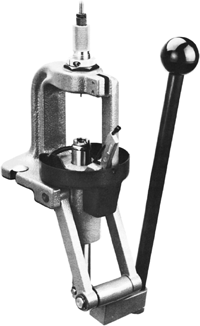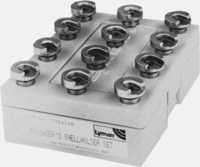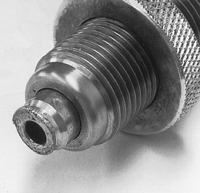Reloading Dies
 Reloading dies come in two basic formats–a two-die set for rifle cartridges and a three-die set for pistol and cast-bullet rifle loading. |
Once a press is purchased, it must be equipped with one set of dies for each different cartridge you reload. For handgun ammunition, the first die decaps the cartridge and resizes it to unfired dimensions, the second expands the case mouth, and the third seats the bullet. Rifle dies do not expand the case mouth since this is not necessary for hard, jacketed bullets. Cast bullets, however, require this expansion to keep them from being accidentally cut by a sharp case mouth.
Dies come in grades from plain to fancy. Basic die sets of steel will last for many years and many thousands of rounds of ammunition. Using tungsten carbide or titanium nitride dies requires little or no lubrication of the cases, which speeds the loading process a bit, and they last longer than steel. Forster, Redding and Jones offer micrometer-adjustable bullet seating dies, while Harrell’s Precision makes a variable base for reforming benchrest cases to near chamber dimensions.
Specialty dies of this sort cost more and are worth the price if you are into competition target shooting. There are special neck-sizing dies for use with bottleneck cases that will only be fired in one particular rifle, thus there is no need to put cases through the wear and tear of full-length resizing. There are custom dies for obsolete calibers and loading cartridges as large as 20mm. Nearly anything your heart desires will cheerfully be made up by the 4-D Custom Die Co. of Mount Vernon, Ohio.
Primer Seaters and Shellholders
 The primer seater, as shown on this RCBS Rock Chucker, is usually included as part of the press, but if you get used equipment, be sure all parts are there. |
Primer seaters generally fit in the front bottom of the reloading press, and you will need one for large diameter primers and another for small primers. It’s probably a good idea to buy both since a pair is generally quite inexpensive. Case or shellholders are needed to hold the case as it inserted into the die. One size does not fit all, but Lee and Lyman offer sets that cover most popular rifle and pistol cartridges.
A real headache is getting the primer crimp out of a military case. A number of die makers offer a useful die to remove this crimp with a stroke of the loading press handle. There is also a chamfering tool to do this, but some prefer a swager die.
Sizer/Lubricators
The second large bench tool you will need is a sizer/lubricator if you are planning on shooting your own cast bullets. In addition to applying lubricant in the grooves of the bullet, the sizer rounds them out to a dimension determined by the sizing die. By the use of various dies, you can control bullet diameters to .001-inch.
Small Bench Tools
These are either mounted on the bench or on the press, or are freestanding on the bench.
Powder scales are absolutely essential when working up loads, as well as for checking those that are measured with a hand dipper or metered by a powder measure. Basic balance scales will do an accurate job, but the speed advantage goes to the electronic models.
Powder measures are not an absolute necessity, but are invaluable when it comes time to get into production loading. They can be mounted on a loading press or a stand. The precision of the adjustment is not all that different. More expensive models adjust faster and a little more precisely, keep their accuracy more consistently, hold more powder and so on. The accuracy of powder-measure metering is mainly dependent on the consistency of the operator as he pulls and returns the handle.
Case trimmers are essential for keeping cartridge length consistent. Cases stretch on firing and in reloading dies, and must be trimmed back every so often.
 Shellholders must be purchased to fit the cartridge you are reloading. Some accept more than one cartridge, and they can be had in sets. |
Hand-cranked models do the job, with a selection of collets and pilots available to handle most common calibers. Collets hold the case head, and pilots guide the case mouth straight against the cutter. Motorized models do the job more quickly.
Hand Tools
Case deburring or chamfering tools come with a bench mount and, in the case of the Forster case trimmer, can be purchased as an add-on feature. They are also made in hand-held versions. These are necessary to take burrs off the outside of a case mouth that has been trimmed and to chamfer (bevel) the inside of the case mouth, removing burrs that will otherwise scratch and gall jacketed bullets.
A primer pocket cleaner can be simply a flat-blade screwdriver, inserted into the primer pocket and turned several times to get the fouling out. However, all the major (and some minor) tool makers have them, and they’re not expensive. The two basic types are the scraper and brush styles, and both do good work.
Getting the primer ash deposit out of the pocket is necessary or the fresh primer will not seat properly. The ash build-up will either result in a high primer or one that may give poor ignition, as the firing pin blow is cushioned and the vent blocked by ash. A steel straightedge ruler will check that your primers are seated deeply enough.
Lyman, Redding, RCBS and others offer case-care kits containing primer pocket cleaners and an assortment of case brushes to remove interior fouling, a good investment if you are loading blackpowder or Pyrodex ammunition. If you want to automate things a bit, Lyman and RCBS have a number of options to do so.
Loading blocks are the best way to keep from double-charging your cases.
They come in molded plastic from several manufacturers and cost very little. You can make your own by drilling holes in a flat piece of 1-inch plank and gluing on a flat bottom. A loading block is the best way to inspect your cases after they have been charged with powder, before you seat a bullet. Double charging is very easy to do, especially when using a powder measure. If you shoot one of these loads, your gun will never forgive you.
Powder funnels cost little, and their use is only way to avoid spilling powder when you are working up loads by weighing each one. A charge drawn from a powder measure and dumped into the pan of your scale for checking is the way to maintain accuracy in your measure. If everything is working as it should, the charge in the pan is then funneled into the case. Forster offers a funnel with a long drop tube for loading nearly compressed charges.
Micrometer/calipers are the best means of making all sorts of precision measurements, like case length, inside and outside diameters, case neck wall thickness, checks for bullet roundness and diameter, case swelling, etc.
Bullet pullers are there for the same reason they put erasers on pencils. Everybody, sooner or later, puts together some loads that won’t fly for one reason or another and need to be taken apart. The two basic types are the one that screws into the die hole on your press and the kinetic type, which looks like a hammer. The press-mounted type is easy to use, but can mar the bullets, making them unshootable.
The kinetic model features a hollow plastic head into which the cartridge is fitted. A wad of cotton or tissue can be used to cushion the bottom of the chamber where the bullet is caught. With this addition, even very soft lead-alloy bullets may be retrieved undamaged. These are very efficient and handy tools.










